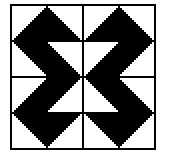Factor completely.
A.
B.
C.
D.
E. Not factorable
Answer: D
You might also like to view...
Solve the problem.In the analysis of the waveform of an AM radio wave, the equation  arises. Find
arises. Find  , assuming that the other quantities are constant.
, assuming that the other quantities are constant.
A. 
B. 
C. 
D. 
Determine the types of symmetry that the quilt pattern below has (line, turn, point), if any.
A. This quilt square has no symmetry. B. This quilt square has 2 lines of symmetry, 180° turn symmetry, and point symmetry. C. This quilt square has 2 lines of symmetry, 90° and 270° turn symmetry. D. This quilt square has 4 lines of symmetry, 90°, 180°, and 270° turn symmetry, and point symmetry.
Use the graph of the function f(x) to locate the local extrema and identify the intervals where the function is concave up and concave down.
A. Local minimum at x = 3; local maximum at x = -3 ; concave up on (0, -3) and (3, ?); concave down on (-3, 3) B. Local maximum at x = 3; local minimum at x = -3 ; concave up on (0, -3) and (3, ?); concave down on (-3, 3) C. Local minimum at x = 3; local maximum at x = -3 ; concave up on (0, ?); concave down on (-?, 0) D. Local minimum at x = 3; local maximum at x = -3 ; concave down on (0, ?); concave up on (-?, 0)
Factor the trinomial completely. If the trinomial cannot be factored, say it is prime.x2 + 9x - 22
A. (x - 11)(x + 2) B. prime C. (x - 11)(x + 1) D. (x + 11)(x - 2)



